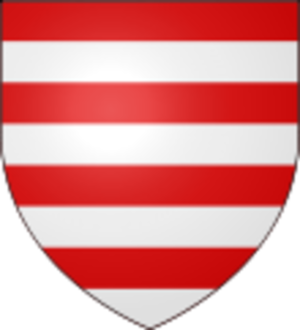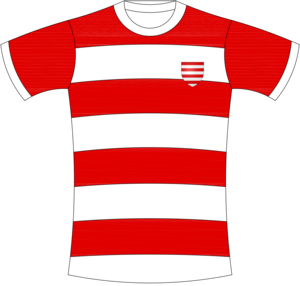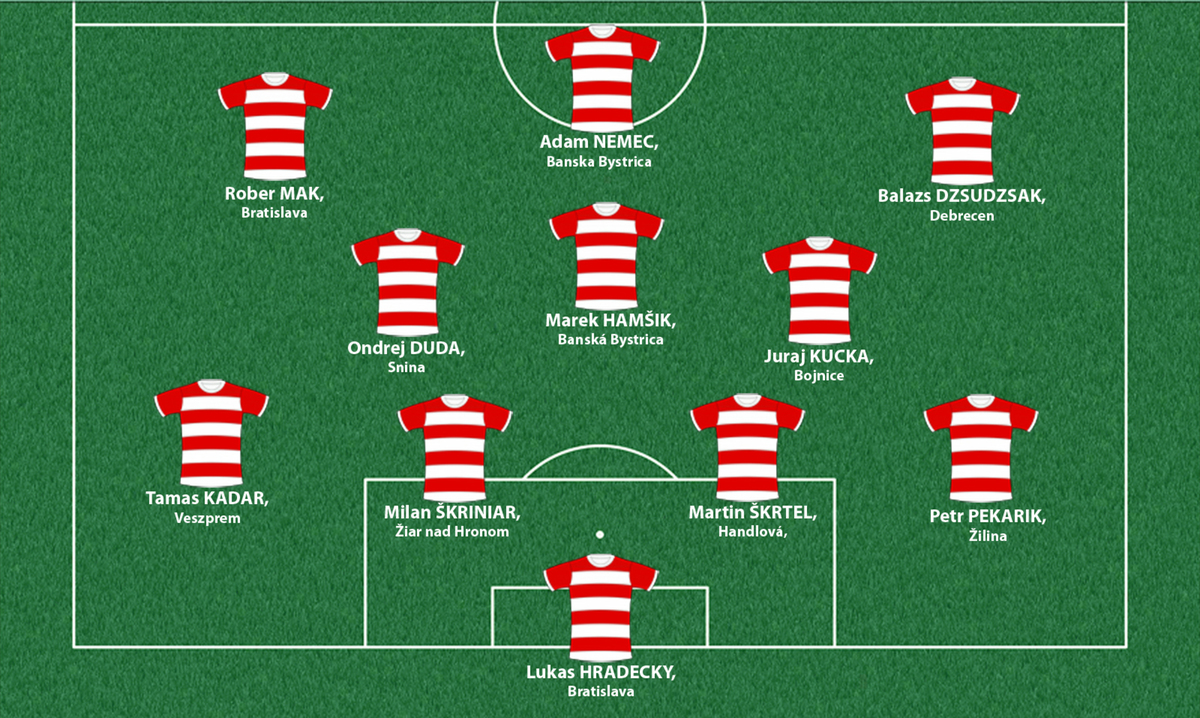Principality of Hungary
In the second half of the 9th century, Central Europe had found itself under attacks by the Hungarians, a nomadic people from the steppes around Dnieper, and the mouth of the Danube. In the end of 9th they established confederation of tribes in the Pannonian Basin.

Coat of arms

Shirt
| Position | First name | Last name | Mjesto rođenja | Like | Dislike | |
|---|---|---|---|---|---|---|
| GK | Lukas | HRADECKY | Bratislava |
15 |
6 |
|
| GK | Martin | DUBRAVKA | Žilina |
5 |
2 |
|
| GK | Peter | GULASCI | Budapest |
8 |
2 |
|
| DC | Adam | LANG | Veszprém |
1 |
0 |
|
| DC | Martin | ŠKRTEL | Handlová |
32 |
10 |
|
| DC | Milan | ŠKRINIAR | Žiar nad Hronom |
41 |
6 |
|
| DC | Nortbert | GYOMBER | Revuca |
2 |
1 |
|
| DC | Roland | JUHASZ | Cegléd |
0 |
0 |
|
| DLC | Tamas | KADAR | Veszprem |
10 |
5 |
|
| DRLC | Tomas | HUBOCAN | Žilina |
4 |
3 |
|
| DR | Atilla | FIOLA | Szekszárd |
0 |
0 |
|
| DR | Petr | PEKARIK | Žilina |
0 |
2 |
|
| DL | Dusan | SVENTO | Ruzomberok |
1 |
0 |
|
| DMC | Patrik | HROŠOVSKY | Prievidza |
0 |
1 |
|
| MC | Adam | NAGY | Budapest |
2 |
0 |
|
| MC | Akos | ELEK | Ózd |
1 |
1 |
|
| MC | Juraj | KUCKA | Bojnice |
10 |
4 |
|
| MC | Stanislav | LOBOTKA | Trenčín |
10 |
6 |
|
| MC | Zoltan | GERA | Pécs |
2 |
0 |
|
| MRC | Matus | BERO | Ilava |
2 |
4 |
|
| AMC | Laszlo | BENEŠ | Dunajská Streda |
6 |
3 |
|
| AMC | Tamas | SZANTO | Sopron |
0 |
1 |
|
| AMC/SS | Marek | HAMŠIK | Banská Bystrica |
39 |
5 |
|
| AMC/SS | Roland | SALLAI | Budapest |
0 |
0 |
|
| AMRL | Balazs | DZSUDZSAK | Debrecen |
8 |
5 |
|
| AMRL | Laszlo | KLEINHEISLER | Kazincbarcika |
2 |
1 |
|
| AMRL | Miroslav | STOCH | Nitra |
3 |
2 |
|
| AMRL | Robert | MAK | Bratislava |
6 |
2 |
|
| AMRL | Vladimir | WEISS | Bratislava |
8 |
2 |
|
| FC | Adam | SZALAI | Budapest |
0 |
0 |
|
| FC | Adam | NEMEC | Banská Bystrica |
6 |
3 |
|
| FC | Norbert | BALOGH | Hajdúböszörmény |
2 |
2 |
|
| FC | Tamas | PRISKIN | Komarno |
2 |
0 |
(Today part of: nothern and central Hungary, Slovakia)
The early history of the Hungarians is vague. It is plain that they had belonged to a clearly defined world of nomads from Asian steppes: all these peoples differed from one another by their language, but their ways of life were similar (horse breeders and warriors). The sudden appearance of their mighty cavalry in the eyes of Christian intellectuals of those times had been compared to the Horsemen of the Apocalypse, who signify the approaching end of the world. In their path, over the Carpathians and through the Pannonian Plain, they tore down the Frankish vassal state of Lower Pannonia, under the rule of Slavic princes, and at the same time caused the migration of the part of the Slavic population towards areas to the north and south. Under the leadership of military commander (gyula) Arpad (ruled 890 – 907), they had settled the Pannonian Plain around the Danube and Tisza, and established a Hungarian state, whose populace comprised of, in addition to the Hungarians, Slavs, Avars, Dacians, Pechenegs, and other peoples.
Arpad’s successors will begin to create a legend around themselves, of how they are the direct descendants of the great warlord Attila the Hun, whose mighty state, with its center in Pannonia, had threatened the Roman Empire in the 5th century. The attacks of Hungarian cavalry against the eastern borders on the Frankish Empire, i.e. the northern-Italian areas, as well as Bavaria, will continue until their defeat at Lechfeld (955 AD), after which they will permanently settle in Pannonia, surrounded by peoples whose languages were unrelated to their own. In medieval world, when pagan peoples were given the choice between annihilation and Christianization, Hungarian rulers started taking on Christianity, seen as how the Emperor of the Holy Roman Empire had threatened the survival of the Hungarian state under the pretext of Christianization in the latter half of the 10th century. Although the rulers had allowed themselves to be Christianized in Constantinople, due to the great distance between themselves and Byzantium, Roman influence prevailed.
Sources
- Marc BLOCH, Feudalno društvo, Zagreb, 2001.
- Grupa autora, Povijest: Rani i razvijeni srednji vijek , knjiga VI., Zagreb 2008.
- Fred HAMORI, ''Legend oft he turul hawk'', http://users.cwnet.com/millenia/turul.htm
- ''Mađarska'', http://www.enciklopedija.hr//natuknica.aspx?ID=37947
- Oto SABOLČ, Maćaš UNGER, ''historija Mađarske'', (http://istorijabl.weebly.com/uploads/9/8/3/5/9835868/macas_unger_oto_sabolc_-_istorija_madjarske.pd
- Coat of Arms
- https://en.wikipedia.org/wiki/%C3%81rp%C3%A1d_stripes
